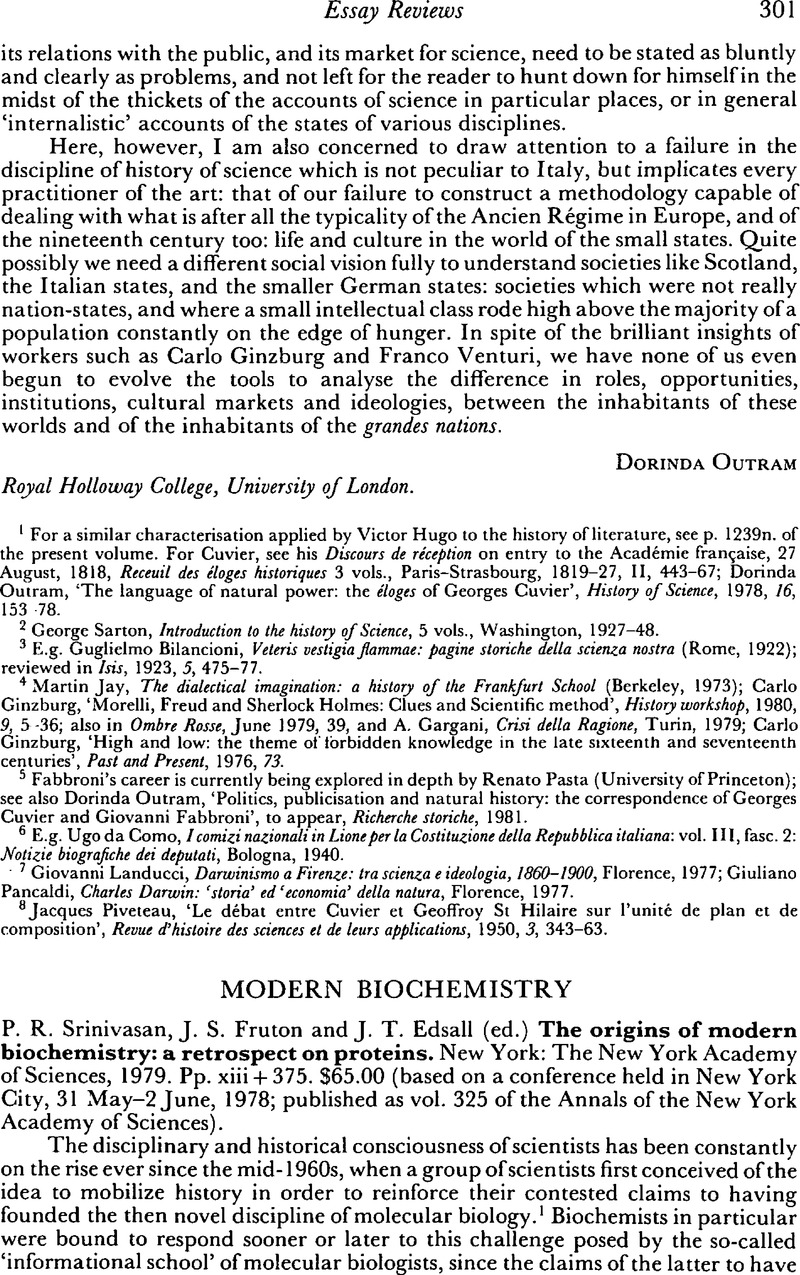Article contents
Modern Biochemistry
Published online by Cambridge University Press: 05 January 2009
Abstract

- Type
- Essay Reviews
- Information
- The British Journal for the History of Science , Volume 15 , Issue 3 , November 1982 , pp. 301 - 305
- Copyright
- Copyright © British Society for the History of Science 1982
References
1 Cairns, J., Stent, G. S. and Watson, J. D. (eds), Phage and the Origins of Molecular Biology, Cold Spring Harbor, N.Y.: Cold Spring Harbor Laboratory, 1966Google Scholar; see also the reviews by Kendrew, J. C., ‘How Molecular Biology Started?’, Scientific American, 1967, 216, 141–3CrossRefGoogle Scholar, which contests the claims of Cairns et al; and by Lewontin, R. C., Journal of the History of Biology, 1968, 1, 155–61Google Scholar, which draws attention to the historical consciousness of the authors as self-acknowledged revolutionaries.
2 Delbruck, M., ‘A Physicist Looks at Biology’Google Scholar in Cairns, et al. , op. cit. note 1, 9–22Google Scholar; Benzer, S., ‘Adventures in rII Region’Google Scholar in Cairns, et al. , op. cit., note 1, 157–65Google Scholar; Kornberg, A., Untitled Review of Cairns et al., Nature, 1967, 214, 538CrossRefGoogle Scholar; Stent, G. S., ‘That Was the Molecular Biology That Was’, Science, 1968, 160, 390–5.CrossRefGoogle Scholar
3 Krebs, H. (Chairman), Biochemistry, ‘Molecular Biology’ and Biological Sciences, London: The Biochemical Society, 1969Google Scholar; this report was issued in response to another report by Kendrew, J. C. (Chairman), Report of the Working Group on Molecular Biology, London: H.M.S.O., 1968.Google Scholar Both Reports were composed by committees of scientists which were chaired by Nobel Prize winners; each committee made a public statement about the priority of one discipline over the other. On the difference between biochemistry and molecular biology see also Chargaff, E., Heraclitean Fire, Sketches of a Life before Nature, New York: Rockefeller University Press, 1978Google Scholar; Abir-Am, P., ‘From Biochemistry to Molecular Biology: DNA and the Acculturated Journey of the Critic of Science Erwin Chargaff’, History and Philosophy of the Life Sciences, 1980, 2, 3–60.Google ScholarPubMed
4 It must be stressed that ‘structure’ in this essay refers to three-dimensional structure. It is unfortunate that several authors in the book under consideration conflate the primary structure of proteins (the sequence of amino acids in a given protein) with the term ‘structure’. ‘Structure’ has usually been associated in the literature on proteins with three dimensional structure. I cannot discuss here how this conflation serves the purpose of biochemists claiming to have made key contribution to ‘protein structure’ by exploiting the metaphoric ambiguity of the term ‘structure’ for different audiences. For an easily accessible statement on the solution of the first three dimensional structures of proteins, see Judson, H. F., ‘Protein—Structure and Function: the solution of how protein molecules work’ in his The Eighth Day of Creation, The Makers of the Revolution in Biology, New York: Simon and Schuster, 1979, 493–604.Google Scholar
5 See for example Fruton, J. S., Molecules and Life: Historical Essays on the Interplay of Chemistry and Biology, New Haven: Yale University Press, 1972Google Scholar; ‘The Emergence of Biochemistry’, Science, 1976, 192, 327–34.Google Scholar
6 For a ‘classic’ statement by a biochemist-historian castigating past thinking for failing to conform to the present wisdom see Florkin, M., ‘The Dark Age of Biocolloidology’ in his A History of Biochemistry Amsterdam: Elsevier, 1972, 279–83.Google Scholar
7 Bernal, J. D., ‘William Thomas Astbury, 1898–1961’, Biographical Memoirs of Fellows of the Royal Society, 1963, 9, 1–35CrossRefGoogle Scholar; Hodgkin, D. M. C., ‘John Desmond Bernal, 1901–1971’, Biographical Memoirs of Fellows of the Royal Society, 1980, 25, 16–84.CrossRefGoogle Scholar
8 On the conception of ‘dynamic biochemistry’ and its centrality in the biochemical ethos see Hopkins, F. G.. ‘The Dynamic Side of Biochemistry’ Nature, 1913, 92, 213–23Google Scholar; Needham, J. and Green, D. (eds) Perspectives in Biochemistry: Thirty-one Essays Presented to Sir Frederick Gowland Hopkins Cambridge: Cambridge University Press, 1938.Google Scholar It is surprising that the first editor of this historically ambitious book, who asserted in his introduction that ‘Modern biochemistry is primarily dynamic biochemistry’ (p. xi), did not mention Hopkins. Hopkins coined the term and is considered as one if not perhaps the founder of biochemistry. At the same time the historical sensitivity of this first editor was further demonstrated when he distributed complimentary copies of this book to the scientist-participants but not to the historian-participants.
9 Pirie, N. W., ‘Patterns of Assumption about Large Molecules’, Archives of Biochemistry and Biophysics, 1962, Suppl. 1, 21–9Google Scholar; Edsall, J. T., ‘Proteins as Macromolecules: An Essay on the Development of the Macromolecule Concept and Some of its Vicissitudes’Google Scholar, ibid., 12–20.
10 Staudinger, H., From Organic Chemistry to Macromolecules New York: Basic Books, 1970Google Scholar; see also Staudinger's Nobel Lecture in 1953 Nobel Lectures in Chemistry, Amsterdam: Elsevier, 1964Google Scholar and the introduction there by Professor Fredga of the Royal Swedish Academy of Sciences; Olby, R., ‘The Significance of the Macromolecules in the Historiography of Molecular Biology’, History and Philosophy of the Life Sciences, 1979, 1, 185–98.Google ScholarPubMed
11 See note 7.
12 For more details on this issue see Chargaff 1978 and Abir-Am, 1980, op. cit., note 3.Google Scholar
- 2
- Cited by




